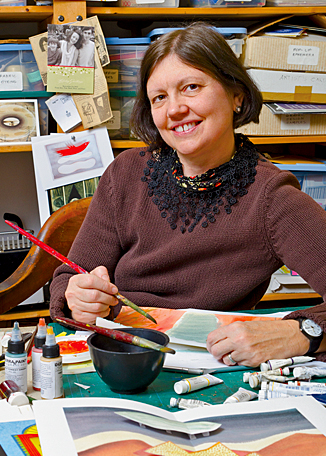
Pop-up books — that centuries-old form of storytelling that transforms flat surfaces into three-dimensional forms with the turn of a page — has found new life in the 21st century through the work of Carol Barton, BFA ’76.
Barton, whose limited-edition pop-up books are in the collections of 37 colleges and 73 libraries and art museums, has also over the past decade written and self-published three how-to books to teach a new generation of paper engineers the wonders of an art form that dates back to medieval times. She has sold 30,000 copies of volume 1 of The Pocket Paper Engineer: How to Make Pop-Ups Step-by-Step. Volume 3, which focuses on V-fold pop-ups, was published in 2012 and provides artists with material and instructions for 10 projects, including pop-up invitations.
She’s currently working with educators at the University of Virginia to develop pop-up projects for elementary and middle-school students that use digital die-cutters to create precise shapes. Making pop-ups requires skills in geometry, trial-and-error problem solving, dimensional visualizations and mechanics.
“The books are quite popular among artists, graphic designers and art teachers,” says Barton, who lives in Glen Echo, Md., with her husband, Henry Barrow, a furniture designer. “We learn through our hands. So it becomes a great way to teach 3-D design.”
After earning a BFA in painting, she turned to pop-up art and embarked on an exploration of this multi-dimensional media that combines graphics with sculpture in a decidedly low-tech process requiring precise cutting, exact folds and just the right glue.
Barton grew up in St. Louis, the daughter of a diesel-engine mechanic whose home workshop she would frequent in order to learn how things worked by taking apart machines and then reassembling them. After earning a BFA in painting, she turned to pop-up art and embarked on an exploration of this multi-dimensional media that combines graphics with sculpture in a decidedly low-tech process requiring precise cutting, exact folds and just the right glue. Her work is in the collections of the Library of Congress, the Museum of Modern Art and the Smithsonian.
One of Barton’s pop-up books, Loom, incorporates Oriental rug patterns with images of landscapes in what’s called a “tunnel book,” with images that collapse and expand in layers of scenery. In Five Luminous Towers, she created a book inspired by historic buildings in Italy, with pop-ups illuminated by a battery-powered flashlight bulb.
“There was such simplicity and grace in her Towers book,” says Ann Montanero, director of the Movable Book Society in Salt Lake City. “And with the light source, she made a wonderful addition to the whole field of limited-edition pop-ups.”
Pop-ups are part of the expanding field in fine arts called book arts, in which artists explore new ways of storytelling through limited-edition books. The rise of the offset press has helped, as artists obtained older letterpresses deemed obsolete by the technological advances in the printing world and incorporated them into their expressive repertoire. When she was an undergraduate, Barton says there were no classes in book arts. Today, classes are offered at universities across the country, including Washington University and the University of the Arts in Philadelphia, where she teaches.
Pop-ups are part of the expanding field in fine arts called book arts, in which artists explore new ways of storytelling through limited-edition books.
With volume 3 of The Pocket Paper Engineer how-to series completed, Barton has returned to painting. She intends to incorporate floating pop-up elements into a series of abstract watercolor landscapes for an upcoming artist book. To transfer the pop-up images from paper to print, she’ll scan them into a computer, then use a digital die-cutter to precisely cut the outlines.
Returning to painting has brought her full circle to her college days, when she focused on painting as the prime avenue for her creative expression.
“I really wanted to get back to painting; it’s my first love,” she says. “While some of my books incorporate painting, this is pure painting. And it feels so satisfying to get back to it.”
— David McKay Wilson
Comments and respectful dialogue are encouraged, but content will be moderated. Please, no personal attacks, obscenity or profanity, selling of commercial products, or endorsements of political candidates or positions. We reserve the right to remove any inappropriate comments. We also cannot address individual medical concerns or provide medical advice in this forum.